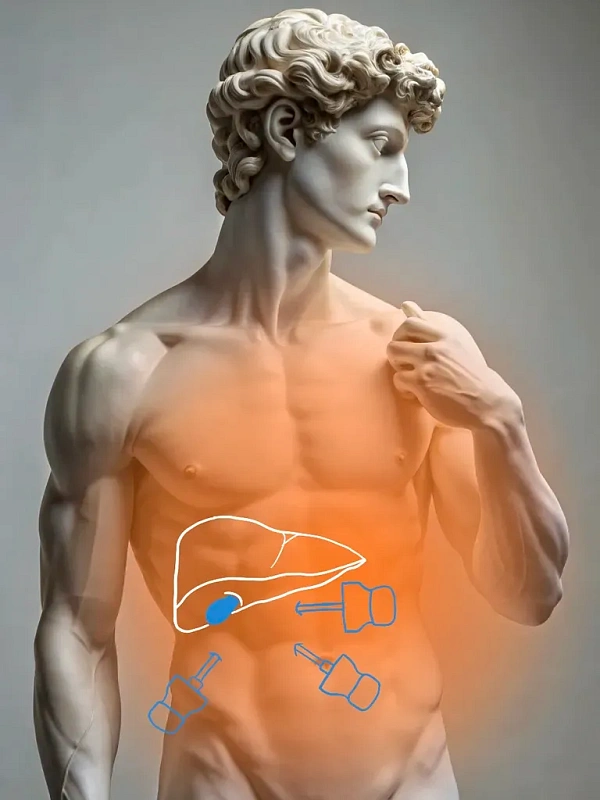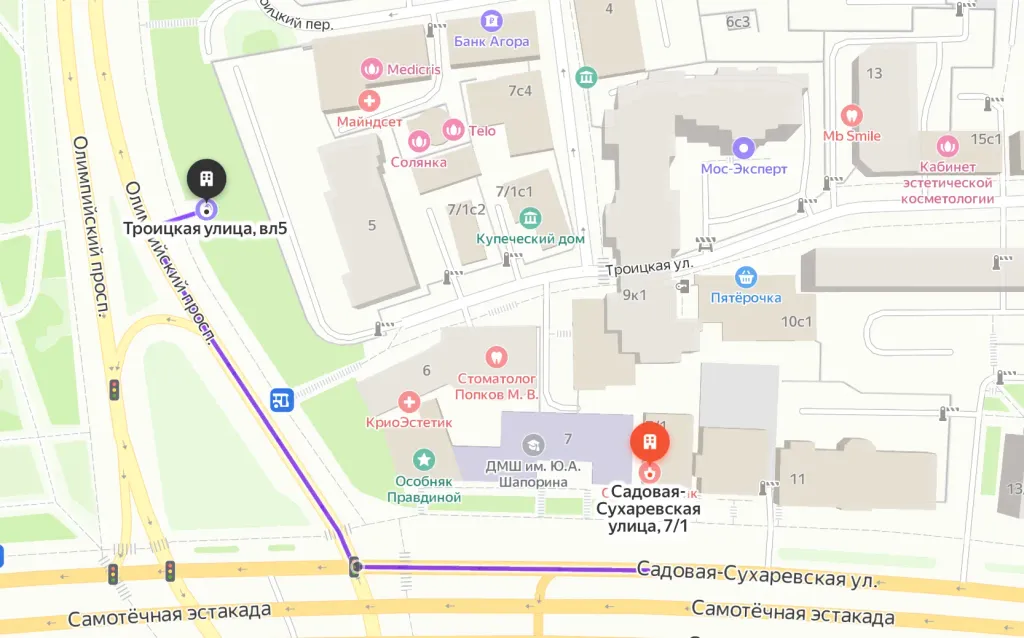Laparoscopic cholecystectomy
This is a minimally invasive operation aimed at removing the gallbladder through small incisions in the abdominal cavity using laparoscopic equipment.

The main indication for laparoscopic cholecystectomy is gallstone disease, in which stones (concretions) form in the gallbladder. They can cause acute inflammatory processes, lead to blockage of the bile duct and acute cholecystitis.
Stones can cause severe pain in the right hypochondrium, nausea and vomiting, especially after eating fatty foods. If left untreated, this pathology can lead to serious complications such as perforation of the gallbladder wall, peritonitis and sepsis. Cholelithiasis affects up to 10-15% of the adult population, and its frequency increases with age. The risk of developing the disease also increases with obesity, pregnancy, diabetes mellitus and metabolic disorders. The advantage of laparoscopy is its minimal invasiveness. Compared with traditional cholecystectomy, which required a large incision and long-term recovery, laparoscopy significantly reduces surgical injuries and allows you to return to normal life faster.
Ultrasound of the abdominal cavity; General and biochemical blood tests; An ECG to assess the state of the cardiovascular system; Fluorography; EGDS (esophagogastroduodenoscopy); Ultrasound of the veins of the lower extremities to eliminate the risk of thromboembolism; Consultation with a therapist, anesthesiologist and surgeon.
Laparoscopic cholecystectomy is performed under general anesthesia. A laparoscope equipped with a miniature camera and instruments are inserted through three small incisions on the abdominal wall. First, the surgeon examines the abdominal cavity, then proceeds to isolate the neck of the gallbladder, bile duct and artery. These structures intersect, and the gallbladder itself separates from the liver. After that, the gallbladder is removed through an incision in the navel area, and the remaining areas are examined for bleeding and treated. The operation usually takes 30-40 minutes, but its duration may vary depending on the complexity of the case.
A laparoscope is a thin tube with a camera and a light source. Surgical manipulators. Electrocoagulants.
After laparoscopic cholecystectomy, the patient usually spends 1-2 days in the hospital. During the first weeks, it is necessary to follow a gentle diet that excludes fatty, fried and spicy dishes. Patients can return to light physical activity after 1-2 weeks, and to full—fledged physical activity after 4-6 weeks. Full recovery takes about 6 weeks.
Benefits
Minimal invasiveness
Less trauma and a faster recovery period compared to traditional surgery.
Fast recovery
Patients can return to normal life within a few days after surgery.
Minimal postoperative pain
A smaller volume of incisions provides less pronounced pain and discomfort.
Lower risk of infections
A smaller wound area reduces the likelihood of infection.
Specialists
Find a SpecialistSimilar referral activities
Gastric bypass surgery
Gastric bypass surgery is the surgical treatment of obesity by reducing the volume of the stomach and changing the way food passes through the digestive system.
Consultation with a surgeon
На приеме врач осматривает пациента, анализирует его жалобы и историю болезни. Это первый этап в диагностике и планировании лечения хирургических заболеваний.
Laparoscopic longitudinal gastric resection
Laparoscopic longitudinal gastric resection is a surgical procedure aimed at reducing the volume of the stomach to treat obesity. It helps to significantly reduce weight and improve health.
Laparoscopy of inguinal hernia
The "gold standard" of surgical removal of inguinal hernia.
Laparoscopy of an umbilical hernia
A low-traumatic operation aimed at eliminating a hernia in the navel area.
Treatment of hernias of the anterior abdominal wall
Surgical removal of pathological protrusion of internal organs through weak spots in the muscle tissue of the abdominal wall.
How to reach
How to get
From the Belorusskaya metro station of the Zamoskvoretskaya line - exit 4 After exiting the subway, walk through the pedestrian tunnel and climb the stairs. Move towards the railway tracks, go down the stairs immediately after them and walk along the house, then turn right onto 1st Yamskoye Pole Street. At the turn to 3rd Yamsky Pole Street, cross the road at the pedestrian crossing and continue along 1st Yamsky Field Street, after a few buildings on the left you will see Olympus Clinic MARS.
Travel time
9 minutes
Landmark
Olympus Clinic MARS sign
How to get
From the Belorusskaya metro station of the Ring line - exit 2. After exiting the subway, turn left and walk to the pedestrian crossing. Cross the road through two pedestrian crossings and move along the Tverskoy overpass. Go down the stairs immediately after the railway tracks, walk along the house, then turn right onto 1st Yamskoye Pole Street. At the turn to 3rd Yamsky Pole Street, cross the road at the pedestrian crossing and continue along 1st Yamsky Field Street, after a few buildings on the left you will see Olympus Clinic MARS
Travel time
11 minutes
Landmark
Olympus Clinic MARS sign
From the metro station "Tsvetnoy Bulvar"
1 exit to the city, then left to the Garden Ring, at the crossing to the right, crossing the boulevard, one more crossing and at the traffic light to the left. The Olymp Clinic building is located overlooking the Garden Ring to the right of the crossing. Travel time is approximately 9 minutes. Landmark - sign Olymp Clini
From the metro station "Sukharevskaya"
Exit 3 from the metro and 640 meters straight ahead, the clinic will be on the right. Landmark - sign Olymp Clinic
Parking lot map
Exit 3 from the metro and 640 meters straight ahead, the clinic will be on the right. Landmark - sign Olymp Clinic

From Sokol metro station
The last car from the center: follow the signs for Exit 5. From the glass doors to the right and go to the end of the passage. Exit to the city by the steps to the left. After exiting the crossing to the street, go straight along Leningradsky Prospekt to the intersection with Chapaevsky Lane. Next, turn right (onto Chapaevsky Lane) and walk to the Triumph Palace residential complex. Entrance to the territory: through checkpoint No. 1, opposite the Vkusville store, you will need to present your passport. After passing through the checkpoint, go up the stairs to the fountain, opposite it you will see our clinic.
Travel time
10-12 minutes
From the Airport metro station
The first car from the center: follow the Exit 2-3 signs. Turn left out of the glass doors and walk to the end of the passage. After exiting the crossing to the street, go straight along Leningradsky Prospekt to the intersection with Chapaevsky Lane. Next, turn left (onto Chapaevsky Lane) and walk to the Triumph Palace residential complex. Entrance to the territory: through checkpoint No. 1, opposite the Vkusville store, you will need to present your passport. After passing through the checkpoint, go up the stairs to the fountain, opposite it you will see our clinic.
Travel time
12-15 minutes
How to get
Entry to the territory is prohibited, but there are free city parking lots around the Triumph Palace residential complex, where you can easily find a place for your car. Free parking area:



